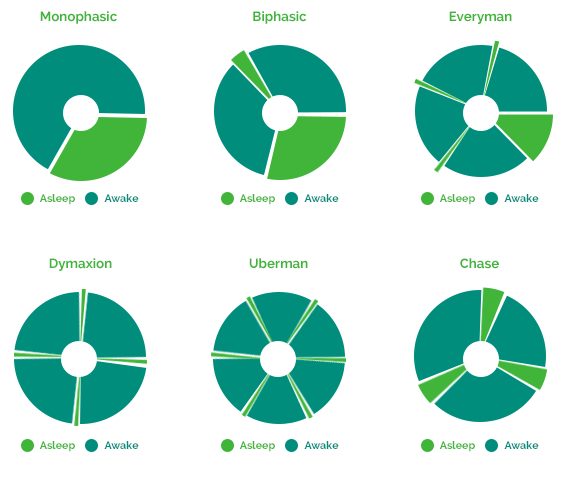Sleep less with Polyphasic Sleep Patterns
You may think the way we sleep now, in a single seven- or eight-hour block, is the way humans have been sleeping for thousands of years. But the truth is, for much of human history, people have slept in segments rather than all at once. Polyphasic sleep refers to sleeping patterns that are broken up throughout the day. In many societies throughout history, people have slept in smaller chunks or napped during the day, either for leisure or necessity. Warriors, for example, slept in short segments to catch up on sleep before reentering battle.
The way most people sleep now is called monophasic, referring to the single chunk we spend in bed each night. But more and more, people are transitioning to polyphasic sleep to improve their sleep quality and decrease their overall time asleep. While many people following a polyphasic routine get the typical seven or eight hours of sleep each day, some people who transition to a polyphasic schedule are able to sleep just two hours a day without becoming sleep-deprived.
Uberman Sleep Schedule
The Uberman sleep schedule, the most popular of the polyphasic sleep routines, consists of six 20-minute naps, which are taken every four hours during the day. Following this sleep schedule, you would get a total of two hours of sleep per day. Some people adapt the schedule so it includes eight naps instead of the traditional six (one every three hours) to get an extra 40 minutes of sleep.
Because the Uberman sleep schedule is a significant departure from the traditional monophasic routine, most people will need the help of others to transition to this new sleep pattern. Expect to spend three to four weeks with significant cognitive impairment as your body adjusts to the new schedule.
The Uberman schedule is one of the most difficult to adapt to, as it is very different from traditional sleep patterns. Many people fail to adapt to this schedule, but still may find success with other polyphasic sleeping patterns.
Everyman Sleep Schedule
The Everyman sleep schedule is an alternative to the Uberman sleep schedule. With the Everyman routine, you sleep for 3 to 3.5 hours at night and then take three 20-minute naps during the day for a total of 4 to 4.5 hours of sleep daily.
The schedule is designed to coincide with when your body is naturally more inclined to sleep. Adherents may get their “core sleep” in the late evening and arise in the very early morning. Many adherents schedule two naps in the morning and the third in the middle of the afternoon.
Several variations to the Everyman sleep schedule exist with differences in the length of the core sleep and the length and number of naps. Experiment to find the one that fits best with your body and schedule.
People adjusting to the Everyman sleep schedule will experience fewer cognitive effects than with Uberman, but should still expect a significant transition period while the body adjusts.
Dymaxion Sleep Schedule
The Dymaxion sleep routine may be the most challenging schedule to master, and it may only work for people who need four or fewer hours of sleep on a monophasic schedule. The Dymaxion routine consists of four 30-minute naps evenly spaced during the day. For most people, this schedule does not provide enough REM sleep to fully recharge.
Some people have experimented with the Dymaxion routine and made adjustments, such as creating a 1.5-hour core sleep with three short naps. This routine may not work for everyone, particularly if you are someone who requires at least 6-8 hours of sleep each night.
Napping and Siestas
These types of sleep schedules, which break sleep up into a long core at night and a shorter midday nap, are the most common type of polyphasic sleep schedules. In fact, many cultures have traditionally encouraged midday naps as a way to recharge, rest, or escape the hot sun. There are many variations to this sleep schedule. Core sleep time may range from 4 to 7 hours, while midday naps range from 20 to 90 minutes. Some people naturally nap for 20 minutes, while others may not wake for an hour or more. Experiment and find out which is best for you.
For many people, this type of schedule is the most realistic for their busy days. One key is not to nap too late in the day because then your siesta may interfere with your nighttime sleep. Also note that you may have to adjust caffeine consumption, which can impact your ability to nap during the day.
Transitioning to a New Sleep Schedule
While many people jump right into a new sleep schedule, you’ll experience fewer adverse effects – and potentially greater success – if you transition slowly. Once you’ve chosen the schedule you want to pursue, work slowly toward your goal by shortening your core sleep time and adding naps at the scheduled times in your day. This will help your body adjust to sleeping at new times.
Gradually reduce your overall sleep time. Keep yourself from sleeping longer than scheduled by using an alarm or a friend or family member to wake you up. If one schedule does not work for you, consider trying another before giving up on polyphasic sleep.
Precautions and Long-Term Effects
Some people should not switch to a polyphasic sleep schedule. Children and people who are in poor health should not use a reduced-sleep polyphasic schedule, as it may create or complicate health problems. Similarly, young adults may need more sleep than older adults to stay healthy and feel rested.
While people have used a variety of sleep schedules throughout history, the long-term effects of polyphasic sleep are not yet known. If you are considering switching to a polyphasic sleep schedule, talk to your doctor about making the transition and whether you should take any precautions.
Sources: Polyphasic Society
Image: http://cdn.techpp.com/wp-content/uploads/2013/12/polyphasic-sleep.png

